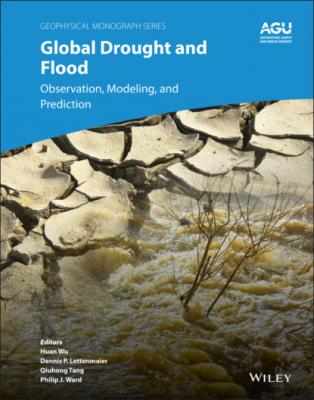Global Drought and Flood. Группа авторов
Читать онлайн.| Название | Global Drought and Flood |
|---|---|
| Автор произведения | Группа авторов |
| Жанр | География |
| Серия | |
| Издательство | География |
| Год выпуска | 0 |
| isbn | 9781119427216 |
Figure 1.2 Near real‐time 0.04° precipitation information provided by the Global Water and Development Information (G‐WADI) map server of University California at Irvine using the PERSIANN‐Cloud Classification System (PERSIANN‐CCS).
One of the major challenges associated with satellite precipitation data is measurement or inference uncertainty due to the presence of uncorrected biases (A. Sorooshian et al., 2008). Studies have shown that although TMPA can be used to produce reliable results when driving hydrological models for monthly streamflow simulation, it does not perform well at the daily timescale (Meng et al., 2014). Since precipitation is a key variable in hydrology, the problem with uncertainty is further aggravated if it is left untreated in drought monitoring and hydrological modeling. As a result, several post‐processing techniques have been developed for bias correction (Khajehei et al., 2018; Madadgar & Moradkhani, 2014). For further information regarding the validation process against ground‐based measurements, interested reader is referred to AghaKouchak et al. (2012), Lu et al. (2018), Mateus et al. (2016), Nasrollahi et al. (2013), Y. Tian et al. (2009), and Xu et al. (2017). Another limitation of satellite precipitation data is associated with their short length of record. Drought analysis requires at least a minimum of 30 years of data (Mckee et al., 1993). Therefore, the near‐real‐time satellite precipitation products such as GPCP with nearly 19 years of recorded data cannot single‐handedly be used to develop drought‐monitoring systems. To remedy this shortcoming, near‐real‐time satellite data are combined with the long‐term GPCP to produce the required timespan for drought calculation (AghaKouchak & Nakhjiri, 2012). In their study, AghaKouchak and Nakhjiri (2012) used a merged product of GPCP (1979–2009) and PERSIANN (2010 to the present) in a Bayesian data‐merging framework to produce a near‐real‐time meteorological drought monitoring system using SPI.
1.2.2. Soil Moisture
Agricultural drought is a result of precipitation deficit plus accumulated evapotranspiration over a prolonged period of time that eventually leads to extended periods of low soil moisture that affect crop yields and livestock production (Cunha et al., 2015). Agricultural drought disrupts the chain of supply and demand of agricultural products and contributes to socioeconomic drought (Wilhite & Glantz, 1985). Soil moisture is a key component of agricultural drought and defines the readily available water that plants can access from the soil through their root system. Soil moisture regulates the water and energy exchange between the land surface and the atmosphere. It also influences the partitioning of nonintercepted precipitation into surface runoff and infiltrations and influences the partitioning of net radiation into sensible, latent, and ground heat fluxes that are essential climate variables (WMO, 2006). Soil moisture condition directly reflects ecosystem functionality and agricultural productivity, therefore an agricultural drought influences the economy at local to global scales (IPCC, 2007; Ryu et al., 2014).
Warm surface temperature and rapidly decreasing soil moisture due to a lack of precipitation and hot temperatures are associated with rapidly developing drought conditions that are often known as “flash droughts” (M. C. Anderson et al., 2013; Otkin et al., 2016). Ford et al. (2015) demonstrated that measurements of soil moisture in situ would drastically enhance the identification of flash droughts. Therefore, identification and quantification of drought at different timescales with high‐resolution satellite imagery is crucial for decision making and developing drought mitigation strategies (D’Odorico et al., 2010). Several drought indices have been proposed to address deficiency in soil moisture, including the Crop Moisture Index (CMI; Palmer, 1965), Keetch–Byram Drought Index (KBDI; Keetch & Byram, 1968), Soil Moisture Percentile (Sheffield et al., 2004), Soil Moisture Deficit Index (SMDI; Narasimhan & Srinivasan, 2005), Scaled Drought Condition Index (SDCI) that uses multisensor data (Rhee et al., 2010), Microwave Integrated Drought Index (MIDI) that integrates precipitation, soil moisture, and land surface temperature derived from microwave sensors such as TRMM and AMSR‐E (Zhang & Jia, 2013), Soil Moisture Drought Index (SODI; Sohrabi et al., 2015), and Standardized Soil Moisture Index (SSI; Hao & Aghakouchak, 2013; Figure 1.3).
Figure 1.3 Near real‐time drought monitoring and prediction system by the Global Integrated Drought Monitoring and Prediction System (GIDMaPS) using the Standardized Soil Moisture Index (SSI) for February 2016 based on the Modern‐Era Retrospective analysis for Research and Applications (MERRA) data set. D0 indicates abnormally dry; D1 moderate drought; D2 severe drought; D3 extreme drought; D4 exceptional drought; and the same applies to wetness (W) scale.
What is required for agricultural drought and land surface models is the water content of the plant root zone in soil. This requires observatories in situ that are able to measure soil‐water content at deeper layers of soil and provide more accurate estimations of soil moisture for purposes of drought monitoring as well as validation of satellite estimations of soil moisture. The cosmic‐ray soil moisture observing system (COSMOS; Zreda et al., 2012) and the German terrestrial environmental observatories (TERENO; Zacharias et al., 2011) are two examples of such in situ measurement networks. Moreover, the International Soil Moisture Network (ISMN) (http://www.ipf.tuwien.ac.at/insitu) provides a long record of global in situ soil moisture data, however, these measurements are typically available at point scales and contain significant spatial and temporal gaps. While point‐based measurements are time consuming and costly, passive and active microwave sensor data retrieved from satellites readily provide spatiotemporally consistent observations of soil moisture from the top 5 cm of soil (Entekhabi et al., 2010; L. Wang & Qu, 2009). Given that agricultural drought monitoring requires information about soil moisture content of the entire soil column (i.e., surface and root
